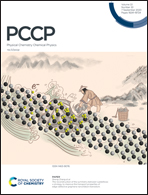Laser-assisted synthesis of gold–graphene oxide nanocomposites: effect of pulse duration†
Abstract
Laser photoreduction of metal ions onto graphene oxide (GO) is a facile, environmentally friendly method to produce functional metal–GO nanocomposites for a variety of applications. This work compares Au–GO nanocomposites prepared by photoreduction of [AuCl4]− in aqueous GO solution using laser pulses of nanosecond (ns) and femtosecond (fs) duration. The presence of GO significantly accelerates the [AuCl4]− photoreduction rate, with a more pronounced effect using ns laser pulses. This difference is rationalized in terms of the stronger interaction of the 532 nm laser wavelength and long pulse duration with the GO. Both the ns and fs lasers produce significant yields of sub-4 nm Au nanoparticles attached to GO, albeit with different size distributions: a broad 5.8 ± 1.9 nm distribution for the ns laser and two distinct distributions of 3.5 ± 0.8 and 10.1 ± 1.4 nm for the fs laser. Despite these differences, both Au–GO nanocomposites had the same high catalytic activity towards p-nitrophenol reduction as compared to unsupported 4–5 nm Au nanoparticles. These results point to the key role of GO photoexcitation in catalyzing metal ion reduction and indicate that both ns and fs lasers are suitable for producing functional metal–GO nanocomposites.

- This article is part of the themed collection: 2020 PCCP HOT Articles


 Please wait while we load your content...
Please wait while we load your content...